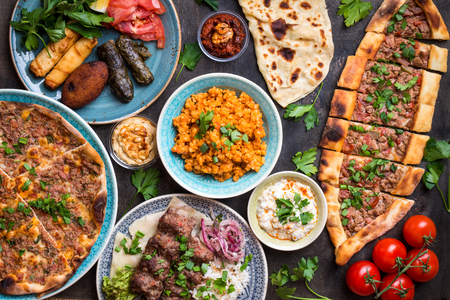Exploring the Top 6 Foods for Hanukkah In 2024

The Culinary Marvels of Hanukkah 2024: A Delectable Journey Embark on an authentic Hanukkah celebration, indulging in a curated array of traditional foods in an enchanting culinary journey. Made with deep appreciation, these delights offer solace and recall an ancient miracle, enriching the culinary experience. Against odds, the miraculous Hanukkah event let Jewish Maccabees light temple lamps for eight nights with oil meant for one. Foods for Hanukkah A Symphony of Gastronomic Wonders Discover the gastronomic marvels that define traditional Hanukkah fare. The comprehensive Hanukkah culinary repertoire presents an assortment of both savory and saccharine delicacies, served as petite indulgences and elaborate courses. The emphasis on fried edibles pays homage to the integral role of oil in the original miracle, creating a symphony of flavors that encapsulates the rich culinary journey of the Jewish people, seamlessly blending European traditions with age-old customs. Mastery in Formulating Traditional Hanukkah Foods/Culinary Delicacies Sufganiot: Embark on a delightful culinary odyssey with Sufganiot – classic jelly-filled pastries, plump and ethereal, adorned with a dusting of powdered sugar. These fried delights tantalize the taste buds, paying homage to the pivotal role of oil in the Hanukkah revelry. The crispy exterior yields to a burst of flavors, introducing a sweet, jelly-filled center. While fruit jelly remains a customary filling, those desiring a twist can indulge in the delightful alternative of sweet custard. The contrasting textures and rich, sweet notes make Sufganiot a cherished treat, intertwining tradition and innovation in the festive tapestry of Hanukkah delights. Kugel: Rooted in Central Europe, kugel emerges as a decadent sweet casserole, a symphony of egg noodles, sugar, eggs, and sour cream. Augmentations like raisins, cinnamon, and nutmeg elevate its richness, creating a dessert resonating with opulence. This indulgent culinary creation finds a special place among the favorite Hanukkah foods, becoming a vessel for encapsulating the cherished flavors of holiday recollections. Its intricate blend of ingredients and meticulous baking process contribute to its opulent nature, making kugel a beloved delicacy, adding a touch of nostalgia and festive delight to the Hanukkah celebration. Challah: Challah, a vital Jewish bread, symbolizes God-sent manna, sustaining wandering Jews during biblical journeys—a profound cultural emblem. On a Hanukkah table, it’s recognized for a crisp, brown exterior, an egg wash, and a substantial braided shape. The bread achieves a perfect balance of crunchiness and fluffiness, ideal for savoring succulent brisket juices. The artful combination of textures enhances the overall dining experience, as each bite encapsulates a rich tradition and adds a layer of gastronomic delight to the festive celebration. You might also be interested in… Persian Food 40Popular Culinary Dishes Brisket: A frequent star on the Jewish Hanukkah culinary stage, the succulent brisket takes center stage for its economical appeal. This meticulously prepared dish undergoes a transformation with a perfect blend of savory herbs such as thyme and sage, simmering in a wine-infused broth. Executed with finesse, the brisket becomes a tender, succulent centerpiece, promising to gratify even the most discerning palates. A festive feast highlight, its rich flavors and tender texture embody traditional Hanukkah culinary excellence. This culinary masterpiece, embraced with expertise, adds indulgence to the celebration, creating a memorable dining experience for all. Latkes: Crispy Potato Pancakes: Honoring temple lamps’ oil, Hanukkah’s standout: crisply fried potato pancakes, crafted with precision, grace the culinary celebration. Crafted from shredded potatoes and onions, akin to hash browns, these delights, topped with applesauce, are a delightful side dish. In crafting these pancakes, attention to detail mirrors the historical celebration, where oil played a crucial role. Symbolizing Hanukkah’s miracle, these pancakes blend tradition and flavor, embodying the festival’s essence on the festive table. Crispy outside, tender inside—a timeless culinary journey linking modern celebrations to their historical origins. Mandelbrot: Mandelbrot, resembling Italian biscotti, aligns with kosher laws by omitting butter or milk. Various ingredients produce a long, crisp cookie filled with almonds, chocolate chips, or dried fruits. Baked twice, it attains the characteristic crunchy exterior. An exceptional Hanukkah delight, Mandelbrot serves as a delightful post-dinner pairing with coffee or tea. Its intricate preparation adds to the festive atmosphere, offering a sweet conclusion to the celebratory meal. Mandelbrot, a delicious addition to Hanukkah traditions, symbolizes joy with rich textures and flavors in the culinary journey. You might also be interested in… Arabic Food 10 Dishes and 7 Culinary insights Embarking on a Culinary Odyssey The prospect of orchestrating an authentic Hanukkah feast may seem somewhat daunting, particularly for those unacquainted with these epicurean offerings. If venturing into this culinary odyssey alone appears formidable, consider enlisting the expertise of a world-class chef. Explore cooking classes in Dallas, Boston, and nationwide for insights into crafting traditional Hanukkah delights. Finding nearby cooking classes and private chefs ensures your festive meal reaches perfection, enhancing your Hanukkah celebration. Explore virtual culinary mastery with online holiday cooking classes, bringing expertise to your home kitchen for a festive experience. For an adventurous spirit eager to explore the menu, these ten Hanukkah dishes offer a robust culinary initiation. These delights, rich in history, elevate your table and immerse you in Hanukkah traditions’ vibrant tapestry. In conclusion, let the culinary odyssey of Hanukkah 2024 be a celebration of flavors, traditions, and the enduring spirit of festivity. May each bite be a tribute to the ancient miracle and a testament to the rich cultural heritage that defines the Hanukkah experience?
Arabic Food Unveiled: 10 Dishes, 7 Culinary Insights

Arabic Food Unveiled: 10 Dishes, 7 Culinary Insights Middle Eastern culinary allure has become a mainstay in Western culture. From ubiquitous kebab shops in most towns to the widespread availability of hummus in quality grocery stores, Middle Eastern cuisine has solidified its presence. This article endeavors to provide a comprehensive understanding of the intricate tapestry that is Middle Eastern gastronomy. Diverse Flavors, Multifaceted Origins The essence of Middle Eastern cuisine manifests in a symphony of bold and intricate flavors, encompassing the spectrum from sweet and savory to spicy and tangy. The ingredients employed are equally diverse, featuring a harmonious blend of fresh vegetables, herbs, spices, grains, and legumes. Let us delve into: The historical roots of Middle Eastern Cuisine, tracing back to ancient influences from Iranian, Egyptian, Syrian, and Mesopotamian cultures. A curated list of exemplary dishes representing various Middle Eastern subcultures, including kofta, baklava, and manakeesh. Unveiling the etiquettes and traditions essential for an authentic Middle Eastern dining experience. Tradition Redefined: Beyond Halloumi and Falafel Situated at the crossroads of Europe, Asia, and Africa, the Middle East is a cultural melting pot, resulting in a delightful fusion of culinary traditions. The Levant, a substantial part of the Middle East, stretching from Africa to Eurasia along the eastern Mediterranean, encompasses nations like Syria, Jordan, Palestine, Israel, and Lebanon. Mezze, a hallmark of Levantine dining, mirrors the Spanish tapas style, presenting an array of small dishes. A typical mezze spread boasts hummus, falafels, olives, pita breads, and dolma, among other delicacies. For the uninitiated, dolma, a topic we’ll explore later, adds an intriguing layer to this gastronomic tableau. Global Influence of Arabic Gastronomy Middle Eastern cuisine doesn’t just absorb influences; it radiates its impact globally. From the bustling streets of France and the United Kingdom to the diverse culinary landscape of the United States, kebab joints have become ubiquitous. These establishments offer not only the quintessential doner kebabs but also falafels, complemented by a medley of freshly shredded salad ingredients. Hummus, tahini, tabbouleh, pickled vegetables, and tzatziki converge within a pita, crafting a delectable kebab experience. The Wellness Quotient of Middle Eastern Fare Dropping by a local doner kebab shop isn’t merely a gustatory delight for many Americans; it’s a health-conscious choice. This Middle Eastern staple has even inspired homemade wraps for clean workday lunches. This segment scrutinizes the health aspect of Middle Eastern cuisine. Vegetal Abundance and Leguminous Goodness Salads play a pivotal role in the doner kebab experience, featuring shredded iceberg lettuce, carrots, and onions. Tabouleh, another salad variety with uncooked bulgur wheat, finely chopped parsley, mint, tomato, and onion, adds a nutritious dimension to kebabs and other Middle Eastern dishes. Additionally, pickled vegetables like beetroot, cucumber, and onion contribute to the preservation of vegetables for out-of-season use. Nourished by Healthy Fats: The Ode to Olive Oil In Middle Eastern culinary realms, butter and olive oil reign supreme. Abundant ancient olive groves across Levantine landscapes provide the cherished olives and their oil, preferred not just for its health benefits but also for its superior flavor. Whether as a standalone dressing or infused with a hint of lemon juice, olive oil takes culinary excellence to new heights. Whole Grains: A Wholesome Foundation Contrary to the prevalent consumption of refined wheat products in the West, the Middle East opts for whole grains. Bulgur wheat, featured in salads and hot dishes, akin to pasta but notably healthier, sometimes graces Middle Eastern tables in its uncooked form, as seen in tabbouleh. Averse to Processed Fare: A Natural Approach Unlike Western reliance on heavily processed foods like pasta, Middle Eastern cuisine adheres to a more natural approach. This eschewal of highly processed ingredients results in dishes brimming with vital nutrients, surpassing their Western counterparts in vitamins and minerals. Moreover, the absence of artificial flavorings or preservatives allows the natural flavors of Middle Eastern dishes to shine through. Flavor Alchemy: Herbal and Spicy Elevation While Western cuisines often rely on sugary or artificially flavored sauces, Middle Eastern gastronomy showcases a masterful interplay of traditional herbs and spices. Yogurt, hummus, and tahini, simple yet rich condiments, harmonize with bold and spicy flavors. These condiments, being natural and protein-packed, eschew artificial additives. Embarking on an Arabic Food Culinary Odyssey: 10 Must-Try Dishes Arabic Food cuisine, spanning a vast geographical expanse, presents a diverse array of dishes rooted in its rich and ancient history. Turkish culinary traditions, interwoven into this tapestry, add a unique flavor profile to the overarching Arabic culinary experience. Fattoush Salad: A Crisp Symphony of Flavors Combining fried or toasted khubz (pita bread) with seasonal vegetables, turnips, cucumber, and salad greens, Fattoush Salad is a textural delight. The dressing, a medley of olive oil, lemon juice, pomegranate molasses, and sumac, introduces a delightful hint of sourness. Tabbouleh Salad: Freshness in Every Bite An uncooked bulgur wheat ensemble with finely chopped mint, parsley, tomatoes, and onions, Tabbouleh Salad adds a refreshing note to kebabs and various Middle Eastern dishes. Mainstays: Shawarma, Kebabs, and Musakhan Recognizable even in hometowns beyond the Middle East, shawarma, kebabs, and Musakhan claim the spotlight. Shawarma refers not just to thinly sliced meat on a vertical rotisserie but also to the wraps in which it’s enjoyed. Shawarma: Culinary Elegance on a Rotisserie Typically lamb or mutton slow-grilled to perfection on a rotisserie, shawarma meat, when paired with fresh salad ingredients and divine sauces, finds its consummate expression in wraps. Soups & Salads: Light Companions to Hearty Meals Soups and salads, often featured in mezze spreads, strike a harmonious balance between lightness and flavor intensity. These culinary offerings complement heartier dishes seamlessly. Halva: Sweet Symphony of Ingredients A dessert concoction featuring milk, cacao, rosewater, oil, butter, and flour, Halva is adorned with various toppings and sweetened with sugar. Its origins in Persian cuisine have seen it embraced across the Middle East and India. Musakhan: Palestine’s Culinary
Decoding Food Aversion In Adults

Decoding Food Aversion In Adults Food aversion is a phenomenon characterized by a strong dislike or avoidance of certain foods, impacting one’s dietary habits and nutrition. It’s important to grasp the causes and solutions to foster a healthy relationship with food. Each of us harbors distinct gustatory yearnings that can persist for days, even extending into weeks. One week, the heart may covet poultry, while the following week, it may pine for a succulent cut of beef. September might unveil an insatiable craving for tacos, whereas October might exclusively comprise leafy salads. These gastronomic inclinations contrast starkly with a general disinterest in the act of nourishment itself. The prevailing misconception is that such peculiar aversions are primarily associated with the developmental phases of children and adolescents as they mature and engage with the external world. However, it is imperative to acknowledge that abrupt food aversions can insidiously infiltrate the lives of grown-ups, leaving acquaintances and family members perplexed at the speed with which this enigma unfolds. Familiarizing oneself with the subtle indicators is crucial, as it enables one to extend assistance to oneself or to a cherished companion when the capacity to ingest specific victuals seemingly evaporates into the ether. The Underlying Factors of Sudden Food Repulsions and Food Aversion A food aversion denotes an intense aversion to a specific comestible. Such aversions are not unusual, provided they are counterbalanced by the incorporation of alternative nutrient sources. However, when food aversions encompass substantial food categories, leaving one foraging for dietary remnants, the ordeal takes on an onerous character. These aversions are attributable to a spectrum of causes, ranging from hormonal shifts to the manifestations of eating disorders. Here are a few of these underlying causes: ARFID – Avoidant/Restrictive Food Intake Disorder (ARFID) manifests as a disinterest in eating, stemming from a variety of triggers, including traumatic experiences, societal influences, or idiosyncrasies such as gustatory preferences and textural attributes. Food Neophobia – Food neophobia epitomizes an unwillingness to sample novel victuals, which can result in selective eating habits or other avoidance behaviors concerning food consumption. Pregnancy – Food aversions can manifest during the initial trimester due to the surge in the human chorionic gonadotropin (hCG) hormone. Identifying Signs of Sudden Food Aversion in an Individual Several conspicuous behavioral manifestations typify individuals who abstain from food consumption, linked to their inclination toward weight loss and gain and the physiological responses to these changes. Watch out for the following alterations: Resisting the ingestion of particular foods. An acute dread of emesis or choking. Apprehension or difficulties associated with dining in the company of family and friends. Dwindling body weight. Stunted growth or a complete absence of growth. A protracted, leisurely pace of eating. While these symptoms are recurrent, other distinctive cues may be discerned. ARFID, as an eating disorder, often results in nutrient insufficiencies. Many individuals afflicted by ARFID may necessitate oral supplements for the preservation of their well-being, and those in close proximity to them may observe alterations in their psychological equilibrium. How to Address the Underlying Causes of Sudden Food Aversion As we’ve discussed previously, it’s acceptable to replace specific foods with alternative nutrient sources that meet essential dietary requirements. When such substitution isn’t feasible, one should explore alternative strategies. Concealing the aversive food within a more palatable medium or altering its texture can render it more appealing. Alternatively, collaboration with a treatment facility like Shoreline or a mental health specialist can illuminate the path to managing ARFID in adults and identifying personalized resolutions. Addressing Disordered Eating with the Shoreline Center for Eating Disorder Treatment Recognizing that abrupt food aversion is an anomaly, it’s crucial not to trivialize it. When grown-ups curtail their dietary intake and exhibit a marked disinterest in food, it should serve as a cause for concern among family members and acquaintances. For those seeking ARFID treatment, do not hesitate to contact the Shoreline Center for Eating Disorder Treatment. Our PHP programs are a vital part of our personalized approach to help individuals with eating disorders. Contact us at 844-707-4190 for guidance on managing food aversions and supporting your loved ones.
